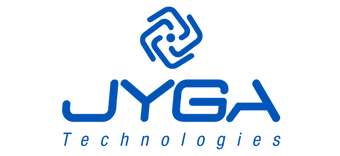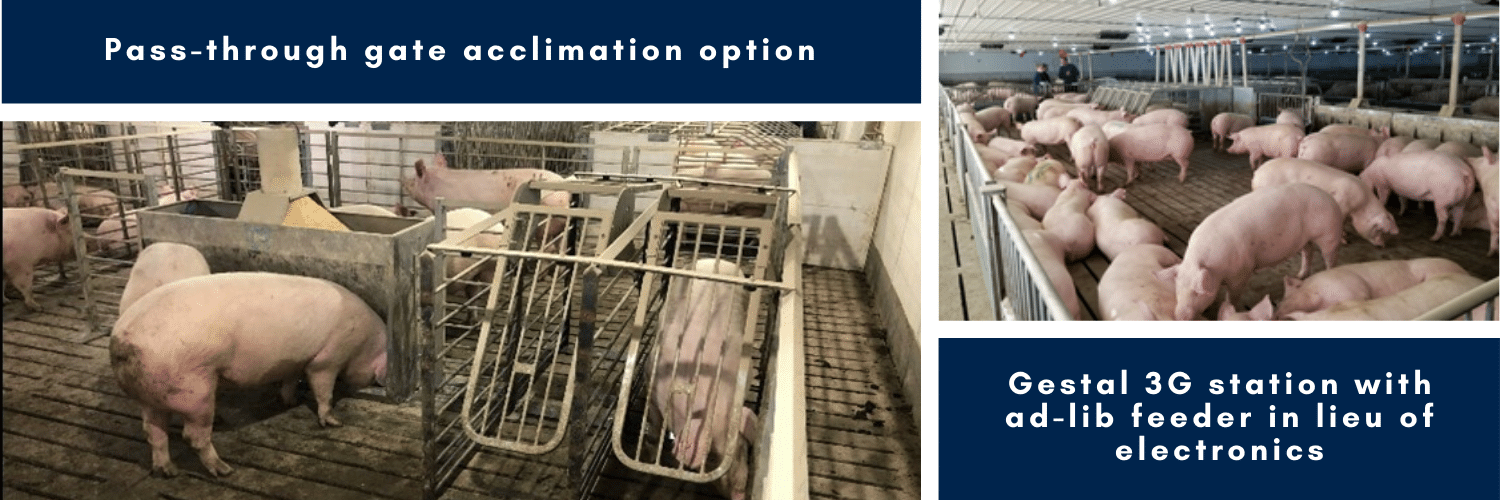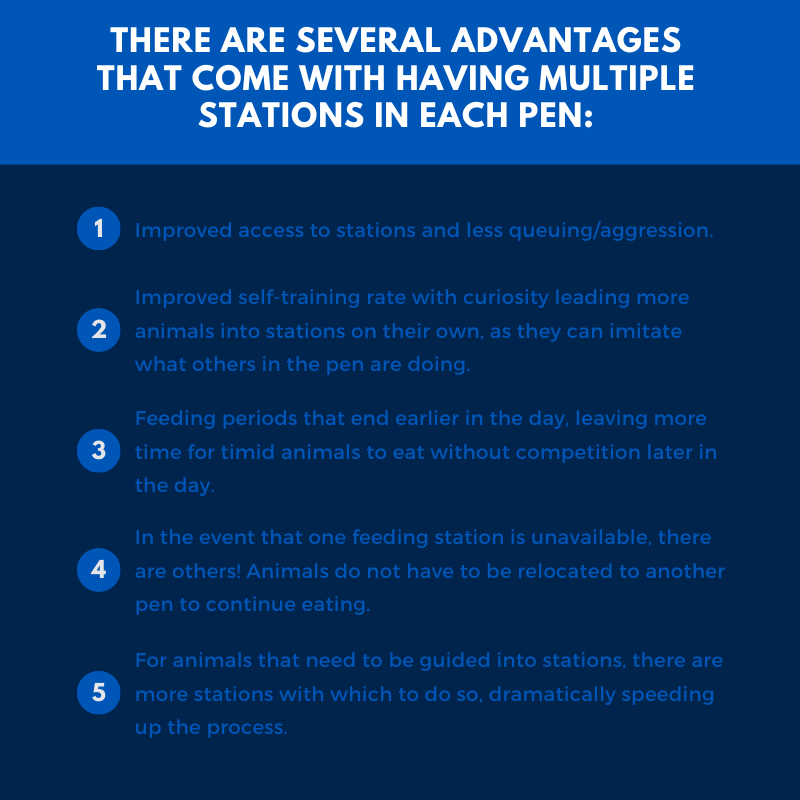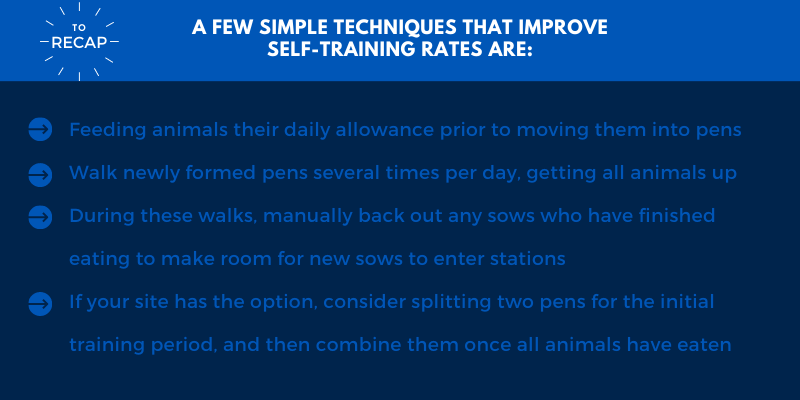Swine Feeding System for Group-Housed Sows : Do Producers Need to Train Their Animals?
By : Amanda Uitermarkt, M.Sc., Sylven Blouin, Agr. and Gratien Thériault
A major concern for many producers who are evaluating the use of electronic sow feeding (ESF) in gestation barns is the impact on labor/staff and how a system that utilizes technology may increase either the time needed to manage group housing, or the quality of staff required to manage group housing, or both. As is the case with conventional European ESF’s, there is indeed a training period required for gilts or animals who have never seen electronic feeding stations previously.
The Gestal 3G system, on the other hand, is a less competitive free-access electronic feeding system and requires minimal amounts of guidance for animals to learn the system, which in turn reduces the labor requirement for managing a Gestal group-housing system. Given that the Gestal 3G is both a smart feeder and a group-housing solution, the focus of this blog is to further differentiate the Gestal 3G system from conventional ESF systems and explain how these differences impact the self-training rate of newly introduced animals.
Is Gilt Training Required?
Conventional ESF = Mandatory Trainer
On a typical 4,000-6,000 head sow farm using a conventional ESF, 1 to 3 employees are generally tasked with full-time gilt training. Although there are many keys to success, there is usually a dedicated GDU training area in which the equipment is installed (at an additional cost to the producer) and these employees use buckets of feed and gating systems to encourage naïve animals to enter feeding stations and learn the process. There is a percentage of animals that are not able to learn to use conventional ESF stations and will be tagged or identified in some way to continue gestating in stalls or to be culled, coming at a high cost to the producer.
In addition, culling rates and sow removal is really high. The sad thing is that is it merely normalized and acepted by producers. Many sows, don’t even reach profitability since they are culled before P2. Here is what Dr. Hyatt Frobose proposes to producers in order to reduce their culling rate.
Gestal Smart Feeder = No Need for a Trainer
With the Gestal 3G system, training stations are not required, saving both cost and farm labor.
Low cost solutions for producers that wish to acclimate
Of course, there are some producers that prefer exposure and acclimation for gilts, and Gestal has developed a couple low-cost solutions to serve the purpose of gilt acclimation. The first option is installation of the “door-only mechanism” to create pass-through areas that will assist young animals in operating the door by themselves. These can be used in small pens and are a cheap and flexible option and are generally paired with ad-lib feeders that can separate feeding, resting, and watering areas.
A second option for gilt acclimation is the use of Gestal 3G stalls with an ad-lib shelf feeder designed for the front of the 3G station in place of any electronics. With the removal of all electronics, this shelf-feeder option is a low-cost solution that some producers prefer to implement in gilt pens.
In general, we recommend pairing these ad-lib 3G stations with standard ad-lib feeders also in the pen that can be turned off for about 24 hours at a time, so as to encourage animals to use the 3G acclimation stations, but not to limit growth on those animals who do not enter the Gestal stations.
How Many of my Animals Will Self-train Using the Gestal 3G System?
While it is important to note that there are several determining factors, such as whether the herd is an established herd moving from stalls to pens, a naïve herd or new startup, genetics, pen layout, flooring type, etc. that will all play a part in how your expectations might differ from another Gestal 3G user, there are some general expectations for the number of animals who will truly “self-train.” Group composition is crucial when transitioning to group housing. Dr. Lori Thomas, Gratien Thériault and Samuel Lefebvre propose some key elements for successful group-housing.
In a Gilt-only Pen
In general, gilt-only pens placed with the recommended ratio of 12-15 animals per station should be expected to self-train at a rate of at least 65-75%, which is oftentimes considerably higher. Of those that do need guided into stations, a vast majority will only need guided into the station once, after which they continue going into stations on their own. This is a vastly different process compared to the standard gilt training required and many days of hands-on guidance for gilts to become successful in using traditional ESF stations.
In a Pen with a Mix of Gilts, P1 and P2
If, instead, these gilts are placed with P1’s (similarly sized animals that have been through the system previously), the self-training rate will increase further.
Anthony Russo, General Manager for Legacy Pork/Epperson Farms, says “crate exposure is key to gilt self-training success, and gilts that have been exposed to crates for at least 14 days train at a much higher rate than those that have limited exposure. Introducing gilts to the Gestal system with similarly sized/small P1 or P2 sows also increases self-training rates. Using these techniques, in combination with acclimation stalls in the GDU with no electronics, the gilt self-training rate should be 80-85%”
In a Mature Sows Gestating Pen
Mature sow self-training rates are more difficult to estimate, as it varies greatly as to what their previous gestation housing type was. For example, if mature sows have previously been group-housed, they will not likely deal with lameness as a factor in addition to a conversion to a new feeding system (as would be the case for previously stalled animals that are converting to group housing).
Tanner McCulley, a Regional Sow Manager for TriOak Foods, has experience with conversions from both stalled and group housed animals to Gestal 3G, and commented “every herd is going to be different, and I have seen anywhere from two-thirds to three-fourths of animals self-training on stations. In my opinion, one of the most beneficial things to do is implementing acclimation ad-lib stalls used in the gilt developer. This added exposure comes in handy when they arrive in 3G stations as bred animals and they have already used stations before.”
The Science Behind the Design of the 3G Station
Individual Gestation Crate Like
The Gestal 3G station was designed in the image of a typical stall used for breeding/gestation, so it is intuitive for animals that they will receive feed if they enter and go to the front of the station. A design that looks like equipment that most animals already use is a key in the success of self-training rates of animals using 3G stations.
Many European ESF’s and our competitors use solid-sided station dividers that inevitably make feeding stations dark and tunnel-like to animals, whereas the 3G station uses galvanized steel open-sided panels that provide additional visibility to our advantage in reducing shadows and increasing the likelihood that animals will enter stations at any time of day.
Gestation Crate Activated by the Sow
While the 3G station is operated entirely by the sow and does not need air cylinders or other mechanical parts to secure the sow in the feed station while eating, there is still a locking mechanism that secures sows in stations for the duration of her feeding period so that she cannot be forcibly kicked out by another animal eager to eat.
The highly–mechanized locking devices in European ESF’s are known to fail often and allow access to stations when the previous sow may not be done eating, in turn causing aggression and potentially impacting body condition and performance of animals.
While animals fed with the Gestal 3G system have the freedom to stay in stations for long periods of time, it is important to note that it was designed without access to water inside the feeding stations, and also with a lay down bar to prevent animals from being comfortable enough to stay in stations for long periods of time. Generally, you will find Gestal animals eating and immediately leaving to find water and lay down once their meal is complete. In addition to speeding up mealtime, the lack of water in the stations also improves cleanliness. This prevents the presence of flies and moldy feed in the trough that is often seen with conventional ESF’s.
Gestation Pen Design is Crucial
More Stations Mean Less Aggression and More Curiosity
European ESF stations are generally more expensive on a cost per station basis and are intended to serve many more animals per station than the Gestal 3G system. While these traditional ESF stations are known to feed up to 60 animals per station, Gestal 3G stations are intended for use with per station. For example, a traditional ESF pen housing 60 sows would likely have one feeding station, while a Gestal pen housing 60 animals would likely have 3 or 4 stations (4 stations and a ratio of 15:1 would be recommended for younger animals, but 3 stations and ratio of up to 20:1 would be acceptable for mature animals).
The feeding day for Gestal 3G users generally starts at midnight, and most sows are done eating by noon, leaving plenty of time for both timid sows to eat, as well as animals who have been identified as non-eaters, to either go in or be put in stations by workers. It greatly improves the efficiency of the process of working a “non-eaters” list when you are not competing with sows who are simply standing in line waiting to eat and don’t need assistance.
Gestating Pen Formations and Techniques
There are several very helpful techniques in newly formed pens
1. Creating a Positive Experience
The key to success in Gestal 3G pens is ensuring that the first visit to stations is a positive experience. Most farms are feeding animals in stalls first thing in the morning, but if possible, it’s important to feed animals their allowance for the day prior to moving them into pens. This is important, because in general, satiated animals will fight less and this also allows for a less-stressful transition to pens and the pen dynamic. With this method, animals who do decide to enter stations and receive a meal on the first day in pens are “rewarded” for the behavior of entering the station.
In effect, it gives farm staff an additional day before they are required to guide any animals who have not entered on their own into a station to eat. In most cases, early-eaters in the pen assist in “training” other animals who have either not been into Gestal stations previously or might have forgotten the process.
2. Walking the Gestation Pen
Next, it is important to recall that prior to moving into pens, animals are accustomed to eating at the same time every day. It is truly an adjustment and a learned behavior that feeding can now occur at any time of day, and it will take a few days for animals to develop eating patterns and schedules. Perhaps the best way to encourage animals to search for feed at a new time of day, and one that is successful in Gestal barns, is to send workers into the barn to walk gestation pens a couple of additional times per day. While animals are up and walking around, they are likely to search for a meal if they have not eaten yet.
3. Positively Encourage Timid Sow with Feed
In addition to walking pens, it can also be helpful to manually back sows out that are lingering in stations and have already consumed their daily allowance. Another technique that can be done with only one person is to drop a small amount of feed inside the 3G station to encourage timid animals to enter the stations and activate the door mechanism.
Once animals are fully in the stations, dropping a small amount of feed with the feeder or sprinkling some feed in the trough is another easy way to get animals to life their heads enough to be detected by the feeder and begin to receive their daily allowance. Implementing any of these strategies are easy and successful ways to ensure that animals have a good experience during their first visit to stations and increase the chances that they will return to stations on their own.
4. Two Steps Gilts’ Mixing in a New Construction Situation
For new construction or start-up herds that are not as tight on stocking space initially, it can be considered to stock pens at half-capacity and then later combine the two pens to form one after all animals have started eating from stations. This has been successful in situations where it is practical in reducing the competition for feeding sources and can improve self-training rates when the ratio of animals per station is less. Animals can be relocated when pens are moved or combined with great ease on the Vision software.
The investment in time and labor for ensuring that both gilts and mature animals are able to easily use a new piece of technology, or in this case a feeding system, is an important consideration when choosing how best to feed animals in gestation. In comparison to many competitive ESF options, the Gestal 3G system was designed with many features to reduce in-pen aggression and achieve the same levels of precision feeding. In addition to ease of use for the animal regarding ability to self-train, the Gestal 3G system has several other features that set it apart from traditional ESF stations:
- Standalone, wireless feeders that feed even when computers are down
- IP66 and NEMA 4X certified (dust and waterproof)
- Do not require major electrical installations (each feeder operates off a single electrical outlet)
- Sensors present in every hopper to prevent animals from being “ghost-fed” during out of feed events, so that these animals can return to eat when feed is again present
Additional information on this topic: Sow Group Housing: Tips and Tricks for Pregnant Sows
